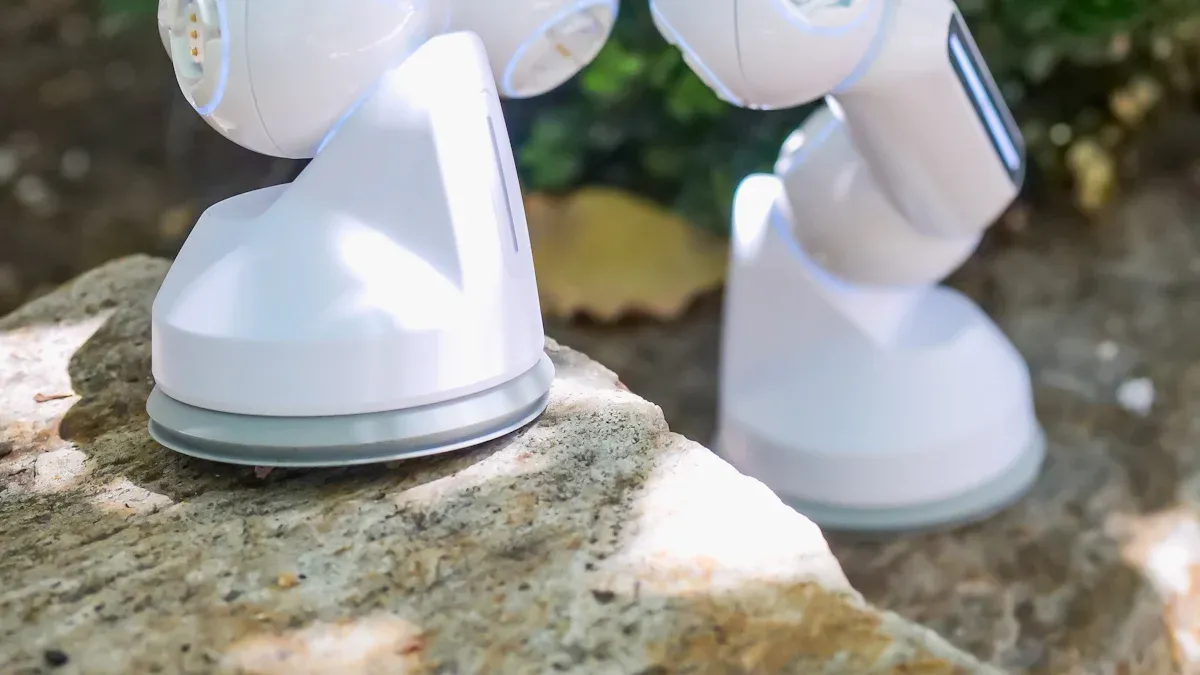Medical Grade Heat Shrink Tubing vs Industrial Grade Explained

Heat shrink tubing is a versatile solution used across industries for insulation, protection, and sealing. Medical Grade Heat Shrink Tubing is specifically designed for healthcare applications, meeting stringent biocompatibility and sterilization standards. In contrast, industrial-grade tubing focuses on durability and resistance to harsh environments.
Feature | Medical Grade Heat Shrink Tubing | Industrial Grade Heat Shrink Tubing |
|---|---|---|
Biocompatibility Testing | USP Class VI | Not applicable |
Material Traceability | Strictly controlled and tracked | Lot traceability only |
Shrink Ratio | 2:1 or 3:1 | 2:1 only |
Choosing the right tubing depends on your application. Evaluate factors like material, shrinkage ratio, and performance needs. This ensures the tubing meets your requirements while remaining cost-effective.
Key Takeaways
Medical-grade heat shrink tubing is safe for healthcare use. It follows strict rules for safety and cleaning, perfect for tools like catheters.
Industrial-grade heat shrink tubing is strong and long-lasting. It handles tough conditions, high heat, and chemicals, great for cars and planes.
Pick the right tubing based on your needs. For medical use, check safety. For industrial use, check strength and durability.
Think about cost. Medical-grade tubing costs more because of strict rules. Industrial-grade tubing is cheaper and good for everyday use.
Always check if it meets the right standards. Medical-grade tubing must follow FDA and ISO rules. Industrial-grade tubing must meet UL and RoHS rules.
What Is Medical-Grade Heat Shrink Tubing?

Definition and Purpose
Medical-grade heat shrink tubing is a specialized type of tubing designed for use in healthcare and medical devices. It provides insulation, protection, and sealing for critical components. This tubing is engineered to meet stringent medical standards, ensuring safety and reliability in sensitive applications. You’ll often find it in devices like catheters, endoscopes, and surgical instruments, where it withstands sterilization methods and enhances device performance.
Key Features and Properties
Biocompatibility and Sterilization
Medical-grade heat shrink tubing offers exceptional biocompatibility, making it safe for use in direct contact with human tissue. It undergoes rigorous testing to meet standards like ISO 10993, ensuring it does not cause adverse reactions. Additionally, this tubing can endure various sterilization methods, including autoclaving and chemical cleaning. For example, FEP sterilizable heat shrink tubing is highly resistant to heat and chemicals, making it ideal for repeated sterilization cycles.
Compliance with Medical Standards (e.g., FDA, ISO 10993)
To ensure patient safety, medical-grade heat shrink tubing complies with strict regulatory standards. It meets FDA requirements and ISO 10993 guidelines for biocompatibility. This compliance guarantees that the tubing performs reliably in medical environments. Its chemical resistance and ability to maintain integrity under stress further enhance its suitability for healthcare applications.
Manufacturing and Quality Control
Cleanroom Production
The production of medical-grade heat shrink tubing takes place in cleanroom environments. This controlled setting minimizes contamination, ensuring the tubing meets the high hygiene standards required for medical use. Cleanroom production is essential for applications like catheter encapsulation and protective sleeves for sensors, where cleanliness directly impacts performance.
Rigorous Testing for Medical Applications
Manufacturers subject medical-grade heat shrink tubing to extensive testing to ensure quality and reliability. Processes like extrusion to tight tolerances, electron beam irradiation for crosslinking, and controlled expansion are critical. These steps enhance the tubing’s durability, electrical insulation, and resistance to chemicals. For instance, FEP sterilizable heat shrink tubing undergoes these processes to deliver consistent performance in demanding medical applications.
What Is Industrial-Grade Heat Shrink Tubing?
Definition and Purpose
Industrial-grade heat shrink tubing is a versatile solution designed to meet the demands of industrial wiring and insulation. You can use it to protect electrical components, provide mechanical reinforcement, and organize wire bundles. This tubing is engineered for durability, making it ideal for harsh environments. It is commonly found in applications like cable jacketing, chafing sleeves, and light-duty bearing surfaces. Its ability to resist abrasion, moisture, and dust ensures reliable performance in challenging conditions.
Key Features and Properties
Durability and Resistance to Harsh Environments
Industrial-grade heat shrink tubing excels in environments where durability is critical. It withstands high temperatures, resists chemical exposure, and offers flame retardancy. For example, it can endure temperatures up to 400°F (204°C) without losing its protective properties. This makes it suitable for industries like automotive, aerospace, and electronics, where components face extreme conditions.
Electrical Insulation and Mechanical Protection
This tubing provides excellent electrical insulation, safeguarding wire bundles and electrical arrays from harmful elements. It also offers mechanical protection, preventing wear and tear caused by abrasion or vibration. You can rely on it to organize and shield electrical components, ensuring long-term reliability.
Manufacturing and Quality Control
Focus on Performance in Industrial Settings
The manufacturing process for industrial-grade heat shrink tubing prioritizes performance. It begins with selecting thermoplastic materials like polyolefin or PVC. These materials are compounded with additives for enhanced properties, such as colorants or stabilizers. The tubing is then extruded, cross-linked through radiation, and expanded before being cooled. This process ensures the tubing meets the demands of industrial wiring and insulation.
Testing for Environmental and Mechanical Stress
Manufacturers implement rigorous testing to guarantee the tubing’s performance. Tests evaluate its resistance to environmental factors like moisture, dust, and chemicals. Mechanical stress tests ensure the tubing can handle abrasion and vibration without compromising its integrity. These quality control measures make industrial-grade heat shrink tubing a reliable choice for demanding applications.
Characteristic | Industrial Grade Heat Shrink Tubing |
|---|---|
Material Traceability | Lot traceability & manufacturing certifications |
Shrink Ratio | 2:1 only |
Manufacturing Conditions | Industrial manufacturing setting, U.S. and off-shore |
Peeling Properties | "Peel inhibitors" added to compound |
Customization | Large volumes required for customization |
💡 Tip: When selecting industrial-grade heat shrink tubing, consider the specific environmental and mechanical challenges your application may face. This ensures optimal performance and longevity.
Key Differences Between Medical-Grade and Industrial-Grade Tubing

Materials and Composition
Biocompatibility vs. Durability
Medical-grade heat shrink tubing prioritizes biocompatibility. It undergoes rigorous testing, such as USP Class VI, to ensure it is safe for contact with human tissue. This makes it ideal for medical devices like catheters and surgical tools. On the other hand, industrial-grade tubing focuses on durability. It resists harsh conditions, including high temperatures and chemical exposure, making it suitable for automotive or aerospace applications. While medical-grade tubing ensures patient safety, industrial-grade tubing excels in protecting components in demanding environments.
Specialized vs. General-Purpose Polymers
The materials used in medical-grade tubing are highly specialized. Manufacturers select polymers that meet strict medical standards, ensuring clarity, consistency, and biocompatibility. For example, FEP and PET are common choices due to their sterilization compatibility. In contrast, industrial-grade tubing uses general-purpose polymers like polyolefin or PVC. These materials are versatile and cost-effective, but they lack the precision required for medical applications. The table below highlights these differences:
Feature | Medical Grade | Industrial Grade |
|---|---|---|
Biocompatibility Testing | USP Class VI | Not applicable |
Material Traceability | Strictly controlled and tracked | Lot traceability only |
Shrink Ratio | 2:1 or 3:1 | 2:1 only |
Manufacturing Standards
Regulatory Compliance (Medical vs. Industrial)
Medical-grade tubing must comply with stringent regulations. It meets FDA requirements and ISO 10993 standards, ensuring safety and efficacy in healthcare settings. For instance, PET heat shrink tubing is designed to meet these rigorous standards, offering biocompatibility and abrasion resistance. Industrial-grade tubing, however, follows less demanding standards. It focuses on general performance rather than safety-critical applications. This difference in compliance reflects the unique demands of each industry.
Type | Regulatory Compliance Requirements |
|---|---|
Medical-Grade Tubing | Subject to stringent standards for safety and efficacy. |
Industrial-Grade Tubing | Follows less rigorous standards, focusing on general performance. |
Cleanroom vs. Standard Production Environments
Medical-grade tubing is manufactured in cleanroom environments. This ensures minimal contamination, which is crucial for medical applications. Cleanroom production also guarantees the tubing meets hygiene standards required for use in devices like endoscopes. Industrial-grade tubing, however, is produced in standard manufacturing settings. While these environments prioritize efficiency and cost, they do not meet the cleanliness levels required for medical-grade products.
Cost and Availability
Higher Costs for Medical-Grade Tubing
Medical-grade heat shrink tubing costs more due to its stringent manufacturing standards and high-quality materials. Regulatory compliance also adds to the expense. These factors ensure the tubing meets the critical demands of medical applications, but they increase production costs. For example, the use of specialized polymers and cleanroom production significantly impacts pricing.
Wider Availability of Industrial-Grade Tubing
Industrial-grade tubing is more widely available. Its production involves general-purpose materials and standard manufacturing processes, making it easier to source. Customization is also more accessible for industrial-grade tubing, though it often requires large order volumes. The table below summarizes these differences:
Feature | Medical Grade Heat Shrink Tubing | Industrial Grade Heat Shrink Tubing |
|---|---|---|
Customization | Easily achieved | Large volumes required |
Clarity Consistency | Lot-controlled | Not applicable |
💡 Tip: When choosing between medical-grade and industrial-grade tubing, consider your application’s specific requirements. Medical-grade tubing offers unmatched safety, while industrial-grade tubing provides cost-effective durability.
How to Choose the Right Heat Shrink Tubing
Assessing Application Requirements
Medical vs. Industrial Use Cases
Choosing the right heat shrink tubing starts with understanding your application. Medical device manufacturing demands tubing that meets strict biocompatibility and sterilization standards. For example, medical-grade tubing ensures safety and durability in devices like catheters and surgical tools. On the other hand, industrial-grade tubing suits environments where durability and high-temperature resistance are critical, such as automotive or aerospace applications. If your application involves pharmaceutical packaging, medical-grade tubing is the better choice due to its compliance with healthcare regulations.
Environmental and Performance Needs
Environmental factors play a significant role in your decision. Consider the chemical environment, temperature, and potential physical trauma the tubing will face. Medical-grade tubing offers high-temperature resistance and can endure sterilization processes, ensuring longevity in medical devices. Industrial-grade tubing, while durable, may not provide the same level of protection for sensitive applications. Additionally, sizing is crucial. Ensure the tubing’s shrink ratio and final dimensions align with your requirements to achieve optimal performance.
💡 Tip: Always evaluate the electrical insulation needs of your application. This ensures compliance with safety standards and prevents malfunctions.
Budget Considerations
Cost of Materials
Your budget influences the type of tubing you choose. Premium brands like Zeus offer high-performance tubing at a higher cost, ideal for critical applications. For budget-conscious buyers, brands like AccuPath provide cost-effective solutions without compromising quality. If customization is necessary, consider that it may increase costs, especially for pharmaceutical packaging or medical device manufacturing.
Long-Term Value and Durability
Investing in higher-quality tubing often pays off in the long run. Medical-grade tubing ensures reliability and reduces the need for frequent replacements in healthcare settings. Industrial-grade tubing, while more affordable, may lack the longevity required for demanding environments. Evaluate factors like frequency of use and recyclability to determine the most cost-effective option for your needs.
Regulatory and Compliance Needs
Medical Standards (e.g., FDA, ISO)
Medical-grade tubing must meet stringent standards like FDA and ISO 10993. These regulations ensure the tubing is safe for contact with human tissue and can withstand sterilization processes. For example, in medical device manufacturing, compliance guarantees that the tubing performs reliably under stress. This is especially important for applications involving pharmaceutical packaging, where safety and precision are paramount.
Industrial Standards (e.g., UL, RoHS)
Industrial-grade tubing follows standards like UL and RoHS, focusing on general performance rather than safety-critical applications. These standards ensure the tubing provides adequate electrical insulation and mechanical protection in industrial environments. While less rigorous than medical standards, they still ensure the tubing meets basic safety and performance requirements.
🔍 Note: Always verify that the tubing you select complies with the relevant standards for your industry. This ensures safety and reliability in your application.
Choosing between medical-grade and industrial-grade heat shrink tubing requires a clear understanding of their differences. Medical-grade tubing prioritizes biocompatibility and regulatory compliance, while industrial-grade tubing focuses on durability and cost-effectiveness. You must evaluate your application’s specific needs to make the right choice.
💡 Tip: Defining your application requirements ensures you select the most appropriate and cost-effective tubing. For example, medical and aerospace applications demand additional considerations beyond standard industrial needs.
Using the wrong tubing can lead to risks like insulation failure, chemical damage, or physical wear. Consult experts or suppliers to ensure your tubing meets all performance and compliance standards.
FAQ
1. Can you use industrial-grade tubing in medical applications?
No, you should not use industrial-grade tubing in medical applications. It lacks biocompatibility and does not meet medical standards like FDA or ISO 10993. Using it in healthcare settings could lead to safety risks and regulatory non-compliance.
2. What is the typical shrink ratio for medical-grade tubing?
Medical-grade tubing typically offers shrink ratios of 2:1 or 3:1. This flexibility allows you to choose the right fit for your application, ensuring a secure and precise seal for medical devices or components.
3. How do you sterilize medical-grade heat shrink tubing?
You can sterilize medical-grade tubing using methods like autoclaving, chemical cleaning, or gamma radiation. These processes ensure the tubing remains safe and effective for use in healthcare environments without compromising its integrity.
4. Is industrial-grade tubing resistant to chemicals?
Yes, industrial-grade tubing resists many chemicals. It performs well in harsh environments, making it suitable for automotive, aerospace, and electrical applications. However, it may not withstand the sterilization processes required for medical use.
5. How do you determine the right tubing for your application?
Evaluate your application’s requirements. Consider factors like biocompatibility, durability, and regulatory compliance. For medical devices, choose tubing that meets FDA and ISO standards. For industrial use, focus on durability and environmental resistance.
💡 Tip: Always consult with suppliers or experts to ensure the tubing meets your specific needs.
See Also
Exploring Non-Toxic FEP Heat Shrink Tubing For Industry
The Importance Of Gamma Resistant Heat Shrink Tubing In Medicine
A Simple Guide To FEP Autoclavable Heat Shrink Tubing
Applications Of Heat Shrink Tubing For Electrical Wire Insulation

